Keep it Simple: What We Can Learn From the Long History of Denim Branding
Using little more than copper, coloured thread, and leather, legacy brands have forged brand identities that, in the case of Levi Strauss and Co., have lasted for nearly a century and a half. Even casual observers can tell the difference between different brands based solely on these unique branding details, and today’s brands have fallen into step with the legacy brands, using arcuates, rivets, and patches to convey their own unique brand identities. Let’s take a closer look at each of these an
Using little more than copper, coloured thread, and leather, legacy brands have forged brand identities that, in the case of Levi Strauss and Co., have lasted for nearly a century and a half. Even casual observers can tell the difference between different brands based solely on these unique branding details, and today’s brands have fallen into step with the legacy brands, using arcuates, rivets, and patches to convey their own unique brand identities. Let’s take a closer look at each of these and see what we can learn.
Arcuates
Originally devised as either a way to affix the pocket lining to the back pockets or simply as a way for brands to distinguish themselves from their competitors, arcuates (brand-specific stitched designs on the back pockets) have long been a key opportunity for brands to make their pairs immediately recognisable. Levi’s started using arcuates sometime in the 1870s—precise dating is impossible due to the 1906 San Francisco earthquake and the subsequent fire that razed Levi’s headquarters to the ground. The immediately recognisable design has been key to their brand identity ever since.

**Picture from Heddels** At first, they might not have realised how powerful this form of branding was. Competing denim brands copied Levi’s wing-shaped arcuate design for nearly three-quarters of a century until the company finally said enough is enough. They trademarked the design in 1943, forcing copycat brands to create their own unique arcuates. Lee and Blue Bell (later Wrangler) had both been using Levi’s-style arcuates up to that point, but the new trademark saw them go their own way with equally iconic designs: Lee’s Lazy S and Wrangler’s W’s.
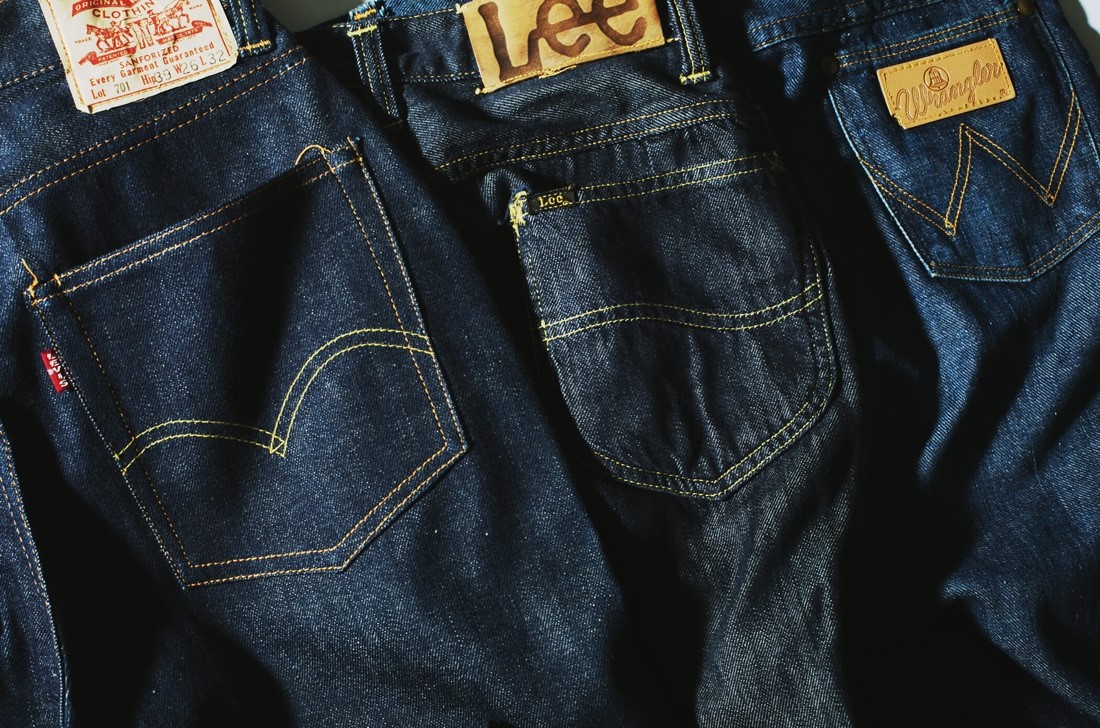
**Picture from Girl Houyhnhnm** When Japanese brands started competing with each other in the ‘80s to produce stitch-perfect reproductions of vintage Levi’s, they infringed upon this trademark quite freely until Levi’s stepped in once again to lay claim to what was theirs and theirs alone. The Japanese brands were, like Lee and Wrangler, forced to go their own way, adding their own unique and distinctly Japanese flavour to their back pocket designs.
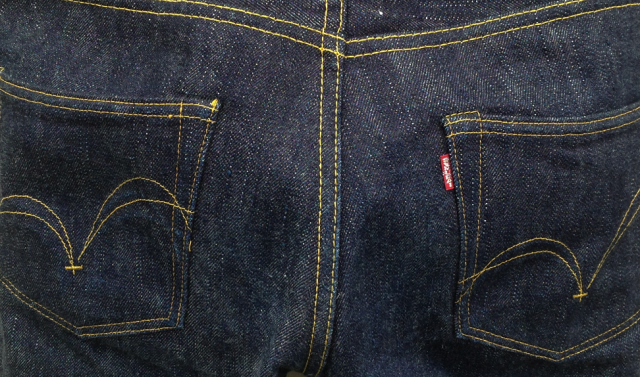
**Samurai Arcuates** At the same time, the denim marketplace was becoming more crowded. European, American, and Asian brands all jostled for space, and each of them tried to use arcuates to distinguish their brands from those of their competitors. In some cases, these designs were beautiful, but some brands took things way too far, turning the seat of our trousers into bejewelled monstrosities.

These are extreme examples, but the more-is-more design principle was rampant around the turn of the twenty-first century. Though few brands go this far today, it’s worth noting that this kind of decorative arms race produced some of the worst-looking pairs in the history of the five-pocket jean.
The Patch
Again, Levi’s led the way with their two-horse leather patch, introduced for the first time in 1886. The beautifully designed patch replaced the leather patch that had sat in the middle of the waistband. These earlier patches were crammed full of information about the patent, including legal threats to those who might infringe upon the company’s rights. The two-horse patch was more than just an improvement; it was an iconic moment for the brand, allowing them to address their market in unmistakable visual language.
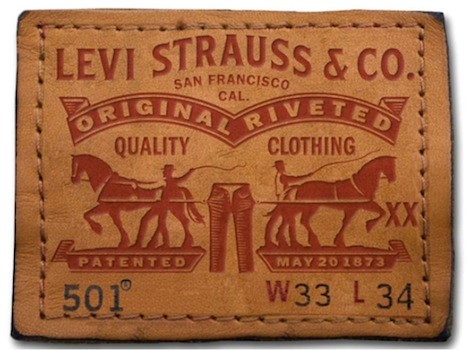
**Picture from Levi’s** This visual language was key to the patch’s marketing success. At the end of the nineteenth century, a significant portion of Levi Strauss and Co.’s customers read either extremely slowly or not at all. Others were freshly arrived from Europe or Asia. They needed a brand identify that was visual, and the new patch gave them this in spades. Customers were soon asking for the “two horse” overalls. Levi’s historian Lynn Downey is reluctant to say that this was the purpose for which the patch was designed (again, the fire of 1906 destroyed the records relating to the patch’s development). It’s likely that we’ll never know for sure why the patch was redesigned in the 1880s, but we can say for certain that the image of two horses trying—trying in vain—to pull apart a pair of riveted overalls is every bit as much a part of the brand’s lasting brand identity as the iconic arcuates.
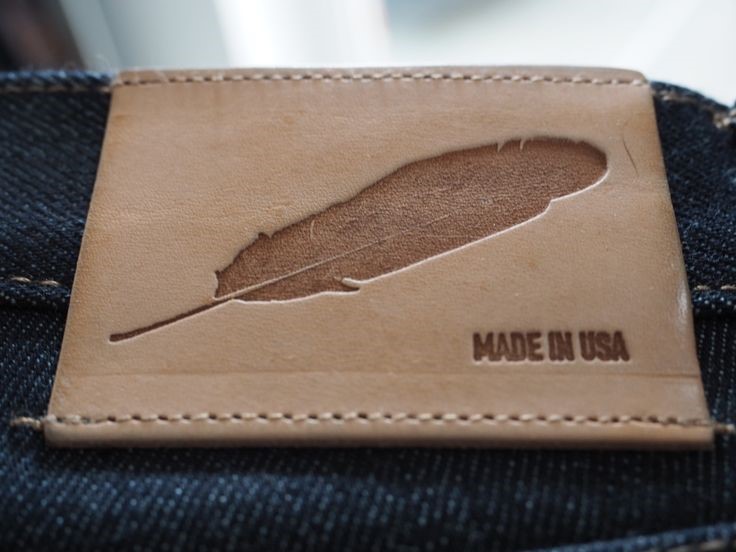
**Rogue Territory’s and Big John’s Beautiful but Simple Patches** Brands today have much to learn from this success. The patch is not the place to be long-winded, and neither is it a place to demand the customer’s attention. The best patches state simply and in unmistakable visual language what the brand values most. Resort to flashy branding at the hip and it’s more likely than not that your brand will be a flash in the pan.
Rivets and Buttons
In 1870, a woman walked into Reno tailor Jacob Davis’s shop and asked him to make a pair of hard-wearing pants for her husband. She had two requests: one, that the pants be large enough to fit his prodigious frame, and two, that they be tougher than usual. The labourer was so hard on his pants that they would fall apart, particularly around the pockets. Jacob took $3 from the woman and began work on the pants. While bent over his workbench, Davis noticed a few rivets left over from his work on saddle blankets. He had used the rivets to affix straps to horse blankets, and he knew they were much stronger than stitched reinforcements, so he had an idea—perhaps the brightest single idea in the history of menswear. He used the rivets to reinforce the corners of the pockets and other areas prone to ripping. Davis approached Levi Strauss with his idea, and riveted waist overalls quickly became the hottest commodity in the West.
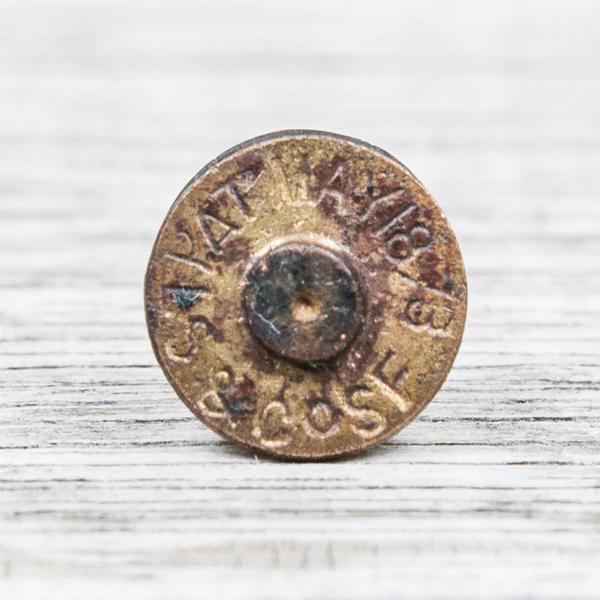
**Picture from Second Sunrise** From very early on, Strauss and Davis recognised the rivet itself as a branding opportunity. While the first pairs that Davis and Strauss produced together probably featured un-embossed rivets, the company quickly started stamping their initials, SF (for San Francisco), and even the date of the patent on each rivet—in some cases, on both sides of the rivet. There is evidence to suggest that they began branding the rivets before the buttons, showing how important this seemingly trivial detail was to the men who were the first to leverage it commercially.

**Denham’s Now-Legendary Golden Rivets ** Picture from Long John** Brands entering the workwear space often forgo branded fasteners. When they do so, they miss an opportunity to showcase their attention to detail. As with patches and arcuates, any attempt to turn rivets and buttons into colourful and attention-grabbing details is often counter-productive, but this doesn’t mean that the fasteners should be left plain. On the contrary, the rivet should be a place to showcase subtlety and the brand’s design sense. Anything less is a missed opportunity. *** These are only a few of the key branding details that brands have used to distinguish their pairs from their competitors’. Woven patches (usually on the inside of the waistband) and tabs (especially red ones) deserve attention as well, but I can make my point without going into detail with these other features.

**Realign Denim’s indigo-thread arcuates are the height of beauty and subtlety** An immediately recognizable brand identity is as crucial now as it has ever been for denim brands, but, when it comes to what today’s pickiest customers expect from branding, less is more. Use every opportunity to stamp your name and image on your product, but speak softly when you do so. Allow the denim itself to draw customers in, pulling them deeper into the beautiful dance between warp and weft. Allow them to discover your branding slowly and purposefully. Always and in all ways, keep it simple.
Sadelikten Yana Olun: Denim Markalarının Uzun Tarihinden Neler Öğrenebiliriz
Bakır, renkli iplik ve deriden fazlasına ihtiyaç duymayan köklü markalar, Levi Strauss and Co. örneğinde olduğu gibi, yaklaşık bir buçuk yüzyıldır süregelen marka kimlikleri oluşturdular. Sıradan bir gözlemci bile, yalnızca bazı detaylara bakarak farklı markalar arasındaki farkı anlayabilir. Günümüz markaları da köklü markaların izinden giderek kendi benzersiz marka kimliklerini oluşturmak için kavis, perçin ve yama kullanıyor. Bunların her birine daha yakından bakalım ve neler öğrenebileceğimizi görelim.
Kavisler
Başlangıçta cep astarını arka ceplere tutturmanın ya da sadece markaların kendilerini rakiplerinden ayırmalarının bir yolu olarak tasarlanan kavisler (arka ceplerin üzerindeki markaya özel dikişli tasarımlar) uzun zamandır markaların jeanlerini özgün hale getirmek için kullandığı bir ögedir. Levi's, 1870'lerde kavis kullanmaya başladı - 1906 San Francisco depremi ve ardından Levi's ana binasını yerle bir eden yangın nedeniyle kesin tarih verilemiyor. Anında fark edilen tasarım özelliği, o zamandan beri marka kimliklerinin ayrılmaz bir parçası haline gelmiştir.

**Heddels'ten bir fotoğraf** İlk başta, bu marka bilinci oluşturma yönteminin ne kadar güçlü ve etkili olabileceğini fark etmemiş olabilirler. Rakip denim markaları, Levi'nin kanat şeklindeki kavisli tasarımını şirket nihayet "artık yeter" diyene kadar yaklaşık üç çeyrek asır boyunca kopyaladı. Levi's, 1943'te tasarımlarını tescilleterek taklitçi markaları kendi kavislerini yapmaya zorladı. Lee ve Blue Bell (daha sonra Wrangler adını aldı) o zamana kadar Levi's tarzı kavisler kullanıyordu, ancak kavislerin tescillenmesinin ardından çareyi eşit derecede ikonik tasarımlar yaratmakta buldular: Lee'nin Lazy S'i ve Wrangler'in W'si.

**Girl Houyhnhnm'dan bir fotoğraf** Japon markaları 80'lerde vintage Levi's jeanlerin kusursuz kopyalarını üretmek için birbirleriyle rekabet etmeye başladılar ve Levi's kendisinin olanı korumak adına araya girene kadar ticari marka haline gelen kavisleri özgürce kopyaladılar. Japon markaları da, Lee ve Wrangler gibi, kendi özgün çözümlerini üretmek zorunda kaldılar ve arka cep tasarımlarına benzersiz ve belirgin Japon dokunuşlarını eklediler.
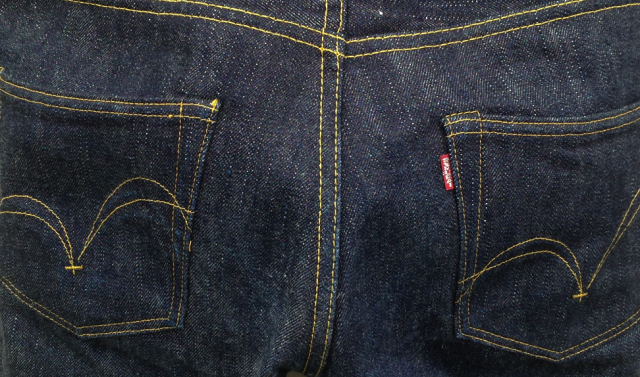
**Samuray Kavisleri** Bu arada, denim pazarı daha kalabalık hale geliyordu. Avrupa, Amerika ve Asya markalarının hepsi çetin bir rekabete girişti ve her biri kendi markalarını rakiplerinden ayırmak için kavisli şekiller kullanmaya çalıştı. Yapılan tasarımlar arasında güzel olanları da vardı ancak bazı markalar işi biraz abarttı ve pantolonların arka kısmını zevksiz bir şekilde süslenmiş birer garabete dönüştürdü.
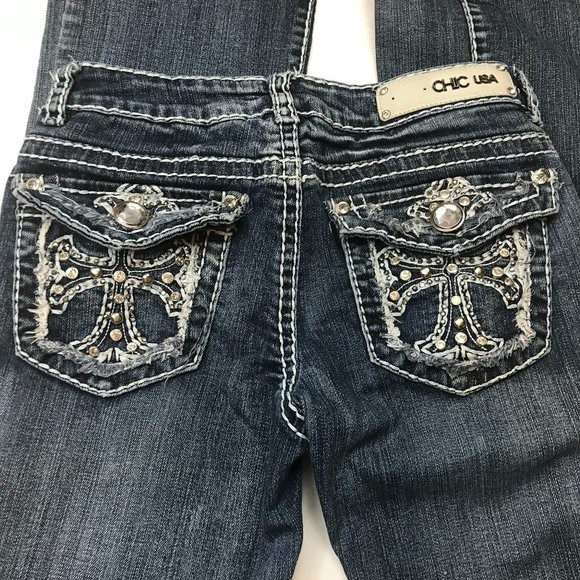
Bunlar elbette uç örnekler ancak abartılı tasarım yaklaşımı yirmi birinci yüzyılın başlarında oldukça yaygındı. Günümüzde çoğu marka bu kadar ileri gitmese de, girişilen bu süsleme yarışı beş cepli jean tarihinde en kötü tasarımların ortaya çıkmasına neden oldu.
Yama
Levi's, 1886'da ilk kez tanıttığı iki atlı deri yama ile sektöre yeniden öncülük etti. Güzel bir tasarıma sahip olan yama, jeanin bel kısmının ortasına oturan deri yamanın yerini aldı. Yamaların ilk örnekleri, şirketin haklarını ihlal edebilecek kişilere yönelik yasal tehditler de dahil olmak üzere, patentle ilgili bilgilerle doluydu. İki atlı yama bir iyileştirmenin daha da ötesindeydi, marka için ikonik bir andı ve hedef kitlesine net bir görsel dille hitap etmesini sağladı.

**Levi’s'ten bir fotoğraf** Bu görsel dil, yamanın yakaladığı pazarlama başarısının anahtarıydı. On dokuzuncu yüzyılın sonunda, Levi Strauss and Co.'nun müşterilerinin önemli bir kısmı ya çok yavaş okuyor ya da hiç okuma yazma bilmiyordu. Diğerleri Avrupa veya Asya'dan henüz yeni gelmişti. Görsel olan bir marka kimliğine ihtiyaçları vardı ve yeni yama onlara bunu fazlasıyla verdi. Müşteriler kısa süre sonra "iki atlı" tulumları istemeye başladılar. Levi's tarihçisi Lynn Downey, yamanın tasarlanma amacının tam olarak bu olduğunu söylemekten çekiniyor (1906 yangını yamanın gelişim aşamalarını gösteren kayıtları da yok etti). Yamanın 1880'lerde neden yeniden tasarlandığını hiçbir zaman tam olarak bilemeyeceğiz, ancak iki atın perçinli tulumları ayırmaya çalıştığı görsel en az ikonik kavisler kadar markanın kalıcı marka kimliğinin bir parçası.
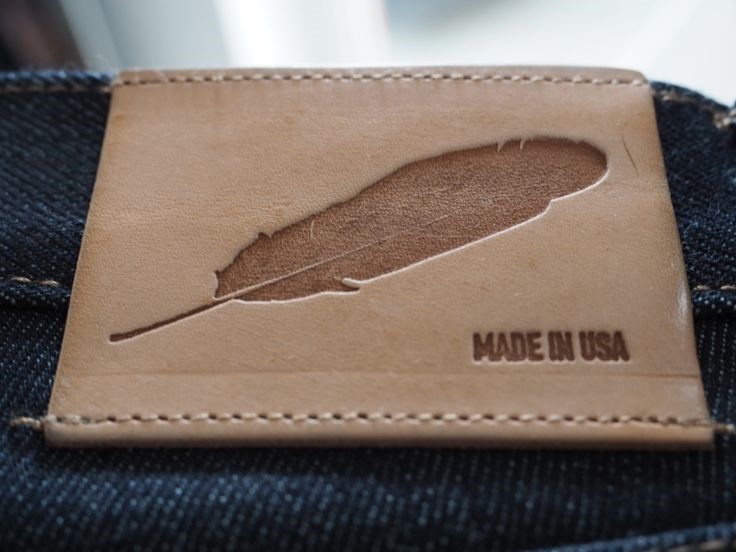
**Rogue Territory ve Big John'un Güzel ama Basit Yamaları** Bugün markaların bu başarıdan öğrenecekleri çok şey var. Yama, sözü çok dolandırmaya gelmez ve müşterinin dikkatini çekmek için cambazlık yapılacak bir alan değildir. En iyi yamalar, markanın en çok neye değer verdiğini basit ve açık bir görsel dilde belirtir. Kalçada cafcaflı tasarımlar kullanarak markanızın ömrünü kısaltmış olursunuz.
Perçin ve Düğmeler
1870’te Reno terzisi Jacob Davis'in dükkânına bir kadın girdi ve ondan kocası için dayanıklı bir pantolon yapmasını istedi. İki isteği vardı: Birincisi, pantolonun iri vücuduna olacak kadar geniş olması ve ikincisi, normalden daha dayanıklı olması. İşçi olan kocası pantolonlarını çok hor kullandığından pantolonları özellikle cep kısımlarında parçalanıyordu. Jacob kadından 3 dolar aldı ve pantolon üzerinde çalışmaya başladı. Davis, tezgahının üzerine eğilirken, eyer örtüsü işlerinden arta kalan birkaç perçin fark etti. At örtülerine kayış takmak için perçinleri kullanmıştı ve bunların dikişli takviyelerden çok daha güçlü olduğunu biliyordu, bu yüzden aklına bir fikir geldi, bu fikir belki de erkek giyim tarihindeki en parlak fikirdi. Ceplerin köşelerini ve yırtılmaya meyilli diğer alanları güçlendirmek için perçinleri kullandı. Davis, Levi Strauss'a bu fikrinden bahsetti ve perçinli bel tulumları hızla Batı'nın en popüler ürünü haline geldi.
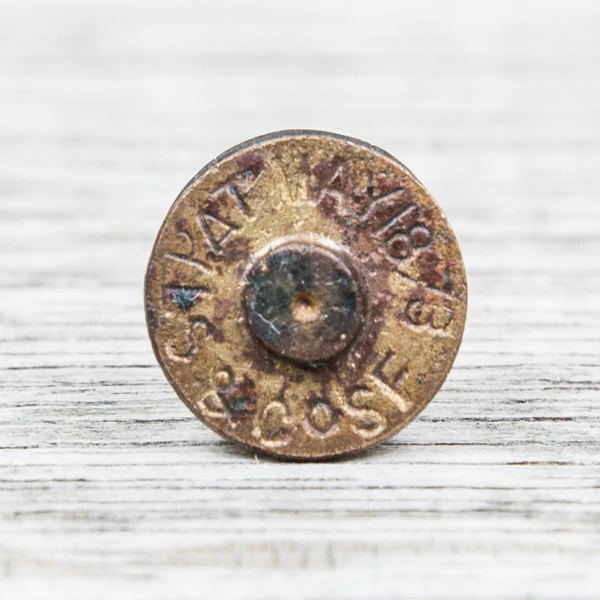
**Second Sunrise'dan Bir Fotoğraf** Strauss ve Davis, en başından beri perçini bir marka bilinci oluşturma fırsatı olarak gördüler. Davis ve Strauss'un birlikte ürettiği ilk jeanler kabartmasız perçinlere sahipken, şirket her perçin üzerine ve bazı durumlarda perçinlerin her iki tarafına da hızla baş harflerini, SF (San Francisco), ve hatta patent tarihini basmaya başladı. Bu marka detaylarını perçinlerin üzerine düğmelerden önce basmaya başladıklarını gösteren kanıtlar var, bu da görünüşte önemsiz bu ayrıntının ticari olarak bu öğeyi ilk kullanan adamlar için ne kadar önemli olduğunu gösteriyor.

**Denham'ın Efsanevi Altın Perçinleri ** Long John'dan bir fotoğraf** İş kıyafetleri alanına giren markalar genellikle markalı perçin kullanmaz. Böyle yaparak ayrıntılara dikkat ettiklerini gösterme fırsatını kaçırırlar. Yamalar ve kavislerde olduğu gibi, perçinleri ve düğmeleri renkli ve dikkat çekici ayrıntılara boğmak genellikle sonuç vermez, ancak bu perçinlerin aşırı sade olması gerektiği anlamına gelmez. Aksine, perçin inceliği ve markanın tasarım anlayışını sergilemelidir. Bunu yapmamak önemli bir fırsatı kaçırmak demektir. *** Bu detaylar, markaların kendi jeanlerini rakiplerinden ayırt etmek için kullandıkları stratejilerden sadece birkaçı. Dokuma yamalar (genellikle belin iç kısmında) ve etiketler (özellikle kırmızı olanlar) de bahse değer tasarım ayrıntıları ancak bunlara değinmeden de söylemek istediklerimi söylemiş oluyorum.
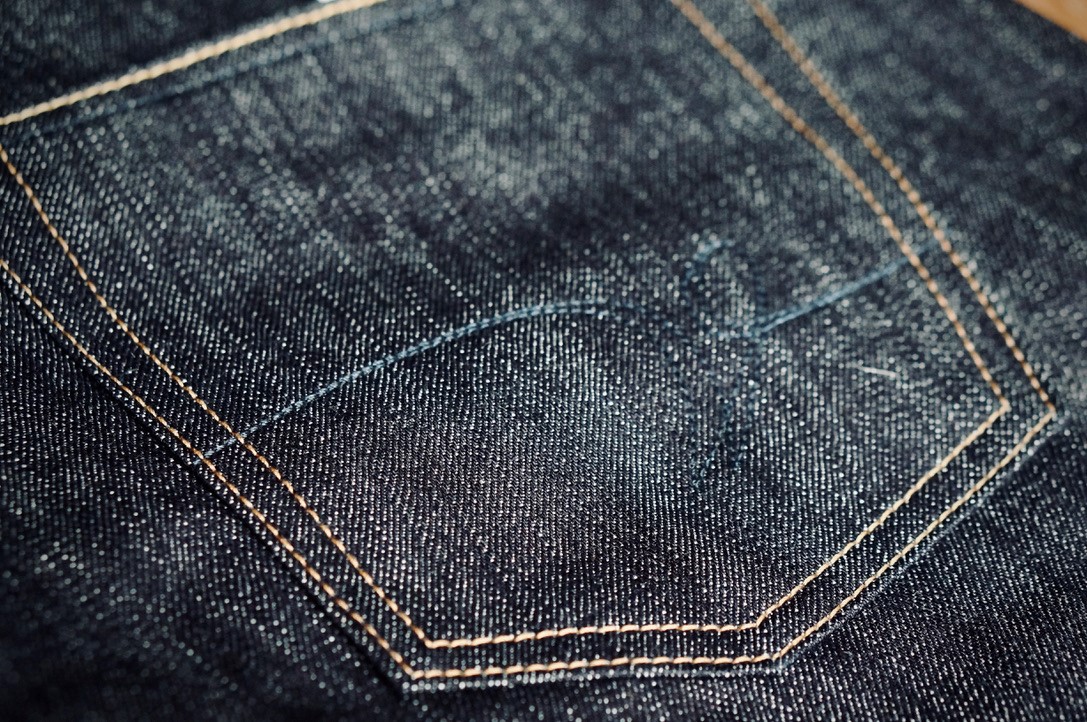
**Realign Denim'in çivit iplik kavisleri, güzelliğin ve inceliğin zirvesidir** Hemen tanınabilir bir marka kimliği, denim markaları için hiç olmadığı kadar önemlidir, ancak günümüz seçici müşterilerinin bir markadan beklediği şey söz konusu olduğunda, bazı şeyleri basit ve sade tutmak her zaman iyidir. Ürününüze adınızı ve resminizi damgalamak için her fırsatı kullanın, ancak bunu zarif bir biçimde yapın. Bırakın ürettiğiniz denim çözgü ve argaç arasındaki ahenge kapılan müşterileri kendine çeksin. Markanızı yavaş ve bilinçli bir şekilde keşfetmelerine izin verin. Her zaman ve her şekilde, sadelikten yana olun.
To view full content and a better mobile experience, try



